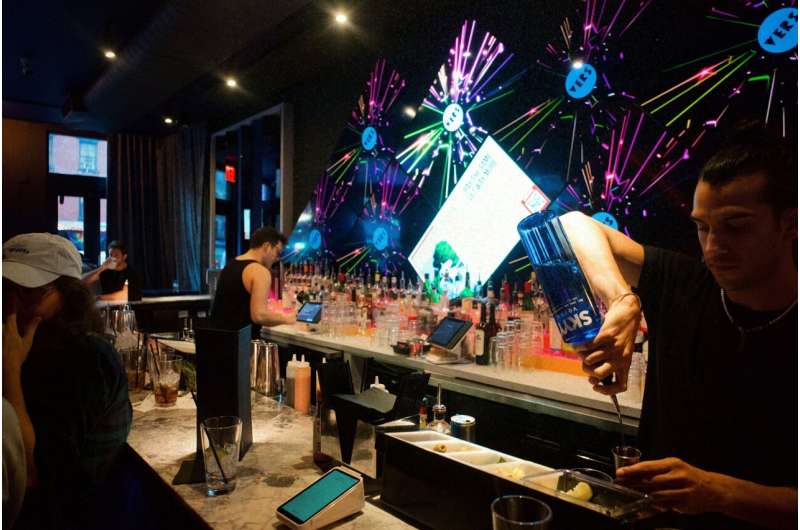This article has been reviewed according to Science X's editorial process and policies. Editors have highlighted the following attributes while ensuring the content's credibility:
fact-checked
trusted source
written by researcher(s)
proofread
Not gay enough: The hidden culture of exclusion within Britain's LGBQT+ nightlife scene

I am a lesbian woman and I have been going on nights out on the LGBTQ+ nightlife scene (better known as the gay scene) for 20 years. My own experiences over the past 18 months have formed part of my ongoing research into lesbian, gay and bisexual (LGB) people's experiences of the gay scene.
Recently I was denied entry to two "diverse and inclusive" LGBTQ+ venues in a large UK city, following a pride event. A group of us who identify as a mix of lesbian and bisexual women were told that we would not be able to go inside, due to being presumed "straight."
Although we were eventually granted access to the second venue after explaining our sexuality, the exclusion did not end there. We received comments from others in the queue, who accused us of not being a part of the "rainbow."
Larger cities such as London, Manchester and Cardiff are often considered places of freedom for the LGBTQ+ community. This is largely due to their thriving LGBTQ+ pub and club scenes. Many of these spaces actively promote and pride themselves on being diverse, inclusive and friendly. They provide a place for LGBTQ+ people to build and maintain romantic, sexual and platonic relationships with others within the community.
Importantly, research has shown that these spaces are also fundamental in helping to shape and establish sexual identities. This allows people in the community to develop a sense of belonging, recognition and affirmation.
However, beneath the rainbow-fronted glow of inclusion and acceptance lies gatekeeping, policing and exclusion from these seemingly welcoming spaces. My research highlights that other harmful behaviors such as unwanted sexual attention, harassment and exclusion are not only prolific in the general night time economy, but also on the gay scene.
A key example of this is people facing judgment from others within the community when they do not present themselves in a way that adheres to LGB stereotypes. This highlights a toxic hyper-focus on physical appearances. The aesthetic hierarchy is maintained among the gay scene through informal policing from the community and more formally, through bouncers or bar staff who become gatekeepers of oppressive and rigid structures.
As one of my research participants, a 23-year-old bisexual woman, told me, "Bouncers always question my sexuality and I get refused entry a lot when I wear a dress and make up because they 'aren't that sort of gay bar' but what am I supposed to do, just kiss the stranger next to me that I don't know, to prove to it? I only really get in if I am with someone who looks gay or is a regular at the club."
My research has shown this to be a common experience. As a 33-year-old lesbian participant explained, "After the bouncers weren't sure if they should let me in because I didn't look gay enough, I waited at the bar for 35 minutes, no-one served me. My more masculine lesbian mate comes along, I explain I can't get served, they tell me it's because I don't look gay enough. I didn't believe them but then they went and got served straight away."
There's little discussion of these topics within the LGBTQ+ community. This means, from the outside, and to many inside it too, the community appears to be a cohesive and supportive environment that is united through shared oppression. However, the exclusion of particular sexual and aesthetic identities within the gay scene means many relationships have become fractured and fraught.
Furthermore, those on the gay scene can feel forced into changing how they present themselves to gain access to LGBTQ+ pubs and clubs. A 23-year-old bisexual male participant explained to me, "I don't meet the gay man aesthetic, so that often excludes me. It's almost like I'm not gay enough to be in a gay bar. I always get refused entry or weird looks because they think I'm straight. I'm forced to change how I look if I wanna be accepted."
Their story also highlights that this is not just an issue of lesbian invisibility, as those who present themselves as more feminine are not the only ones who face exclusion.
Being excluded from the gay scene as an LGB person based on who you are presumed to have sex with, or how you dress, creates rigidity within a community that prides itself on freedom, authenticity and individuality. It means that those who may not feel safe in "hetero night life," may also face exclusion from their own community because of the entrenched social and sexual bodily norms set out by the gay scene. More needs to be done urgently to ensure equality across the community.
Provided by The Conversation
This article is republished from The Conversation under a Creative Commons license. Read the original article.![]()





















